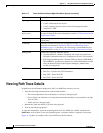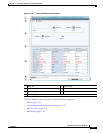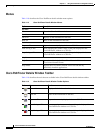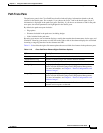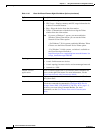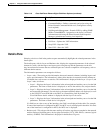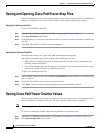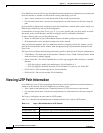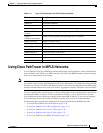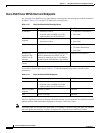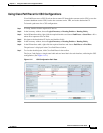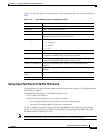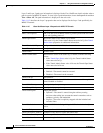
11-28
Cisco Prime Network 4.0 User Guide
OL-29343-01
Chapter 11 Using Cisco PathTracer to Diagnose Problems
Viewing L2TP Path Information
Cisco PathTracer uses the VLAN tags of the Ethernet header and the port configuration to trace the path
from one interface to another over the network. Among other things, you can:
• View a Layer 2 path across a LAN domain with all the VLAN tag information.
• For each network element, view the relevant parameters for each interface on all layers along the
path.
Q-in-Q and Dot1q information is displayed in the Cisco PathTracer window when a path is traced over
Ethernet ports with Dot1q and a Q-in-Q configuration.
As described in Launching Path Tracer, page 11-3, to view a specific path, you must specify an initial
start point, such as an IP interface, and then an endpoint, such as a destination IP address.
To trace a Q-in-Q path, you start the path from any:
• Router or switch that is part of the Ethernet domain with Dot1q and Q-in-Q configurations.
• IP destination that can be reached from that point of the network.
After you select the endpoint, the Cisco PathTracer window is displayed. From this window, you can
open the Cisco PathTracer details window, with the appropriate Q-in-Q information displayed in the
Layer 2 tab.
The Layer 2 tab can display the following information specific to Q-in-Q and VLAN port configurations:
• VLAN Mode—The work mode for the interface: Unknown, Access, Trunk, or Dot1Q Tunnel. Trunk
mode also refers to multiple tagging.
• Native VLAN ID—The VLAN identifier that is used to tag untagged traffic received on a trunked
interface:
–
If VLAN tagging is enabled, the default native VLAN identifier is 1.
–
If VLAN tagging is disabled, the native VLAN identifier is 0 (zero) or “no VLAN ID.”
• CE VLAN ID—The customer edge device VLAN identifier.
• SP VLAN ID—The service provider VLAN identifier.
Viewing L2TP Path Information
Cisco PathTracer uses VC ID encapsulation information to trace the path from one tunnel interface to
another over the network. The Cisco PathTracer tool enables you to:
• View a path for the defined Layer 2 Tunneling Protocol (L2TP) session across the network.
• For each network element, view the relevant parameters for each interface on all layers along the
path.
The Layer 3 tab displays the peer name for L2TP tunnels.
Table 11-11 describes the information that is displayed in the Layer 2 tab for L2TP tunnels.
Table 11-11 Layer 2 Tab Information for L2TP Tunnels
Field Description
Encapsulation Type Encapsulation type, such as Point-to-Point Protocol over ATM (PPPoA).
Binding Information Name of the subscriber.
Binding Status Binding status: bound or unbound.
Tunnel Session Count Number of current sessions.



